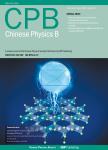Selective enhancement of green upconversion luminescence of Er-Yb:NaYF4 by surface plasmon resonance of W18O49 nanoflowers and applications in temperature sensing
Selective enhancement of green upconversion luminescence of Er-Yb: NaYF_4 by surface plasmon resonance of W_(18)O_(49) nanoflowers and applications in temperature sensing作者机构:School of Chemistry and Chemical Engineering Liaoning Normal University Dalian 116029 China Department of Physics Dalian Maritime University Dalian 116026 China Key Laboratory of Photosensitive Materials and Device of Liaoning ProvinceKey Laboratory of New Energy and Rare Earth Resource Utilization of State Ethnic Affairs Commission School of Physics and Materials Engineering Dalian Minzu University Dalian 116600 China
出 版 物:《Chinese Physics B》 (中国物理B(英文版))
年 卷 期:2018年第27卷第9期
页 面:151-156页
核心收录:
学科分类:081702[工学-化学工艺] 07[理学] 08[工学] 0817[工学-化学工程与技术] 070205[理学-凝聚态物理] 080501[工学-材料物理与化学] 0805[工学-材料科学与工程(可授工学、理学学位)] 0704[理学-天文学] 0702[理学-物理学]
基 金:Project supported by the National Natural Science Foundation of China(Grant Nos.11474046 and 61775024) the Program for Liaoning Innovation Team in University,China(Grant No.LT2016011) the Science and Technique Foundation of Dalian,China(Grant Nos.2017RD12 and 2015J12JH201) the Fundamental Research Funds for the Central Universities,China(Grant No.DC201502080203)
主 题:upconversion localized surface plasmon resonance Er-Yb: NaYF4/W18O49 temperature sensing
摘 要:The W(18)O(49) nanoflowers with a diameter of 500 nm are prepared by a facile hydrothermal method. The Er-Yb:NaYF4 nanoparticles are adsorbed on the petals(the position of the strongest local electric field on W(18)O(49) nanoflowers).With a 976 nm laser diode(LD) as an excitation source, the selectively green upconversion luminescence(UCL) is observed to be enhanced by two orders of magnitude in Er-Yb: NaYF4/W(18)O(49) nanoflowers heterostructures. It suggests that the near infrared(NIR)-excited localized surface plasmon resonance(LSPR) of W(18)O(49) is primarily responsible for the enhanced UCL, which could be partly reabsorbed by the W(18)O(49), thus leading to the selective enhancement of green UCL for the Er-Yb: NaYF4. The fluorescence intensity ratio is investigated as a function of temperature based on the intense green UCL, which indicates that Er-Yb: NaYF4/W(18)O(49) nanoflower heterostructures have good potential for developing into temperature sensors.



